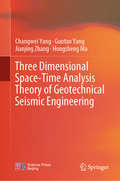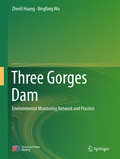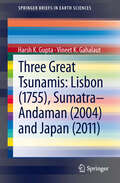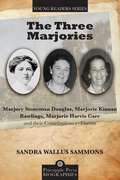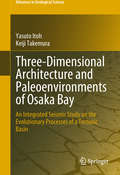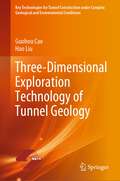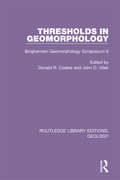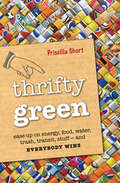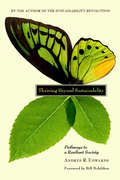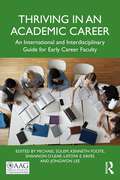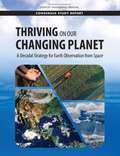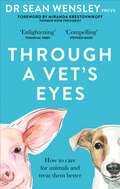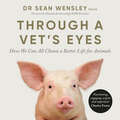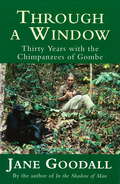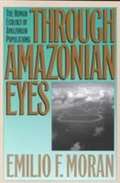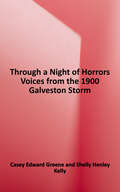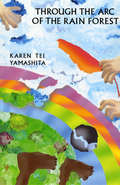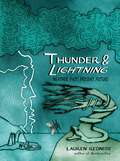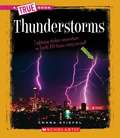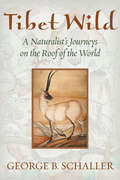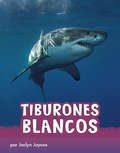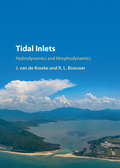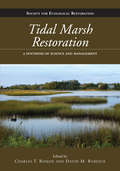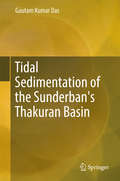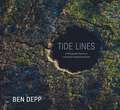- Table View
- List View
Three Dimensional Space-Time Analysis Theory of Geotechnical Seismic Engineering
by Changwei Yang Guotao Yang Jianjing Zhang Hongsheng MaWritten by respected experts, this book presents essential findings on the Wenchuan earthquake. It establishes a series of time–frequency analysis methods, and subsequently applies them to the layered site, slope, and earth-retaining wall. Further, it examines various cases and their solutions, and shares the results of numerous shaking-table tests and numerical simulations. As such, it is a valuable resource for researchers and engineers in the fields of geotechnical engineering and anti-seismic engineering.
Three Gorges Dam
by Zhenli Huang Bingfang WuThis is the first English book talking about the Three Gorges Project Eco-Environmental Monitoring System (TGPEEMS). It presents lessons learned in construction of large dam projects at home and abroad in this field, identifies existing problems before suggesting a scientific improvement plan. and, most importantly, it studies modification of the TGPEEMS to adapt it to the changing situation after the impoundment of the reservoir, and provides an essential overview of measures and progress in the ecological and environmental protection for the ongoing project. As such, it offers a valuable reference guide for both researchers and environmental decision-makers. Prof. Zhenli Huang works at the National Research Center for Sustainable Hydropower Research, China Institute of Water Resources and Hydropower Research. Prof. Bingfang Wu works at the Institute of Remote Sensing Applications, Chinese Academy of Sciences, China.
Three Great Tsunamis: Lisbon (1755), Sumatra-Andaman (2004) and Japan (2011)
by Harsh K. Gupta Vineet K. GahalautTsunamis are primarily caused by earthquakes. Under favourable geological conditions, when a large earthquake occurs below the sea bed and the resultant rupture causes a vertical displacement of the ocean bed, the entire column of water above it is displaced, causing a tsunami. In the ocean, tsunamis do not reach great heights but can travel at velocities of up to 1000 km/hour. As a tsunami reaches shallow sea depths, there is a decrease in its velocity and an increase in its height. Tsunamis are known to have reached heights of several tens of meters and inundate several kilometres inland from the shore. Tsunamis can also be caused by displacement of substantial amounts of water by landslides, volcanic eruptions, glacier calving and rarely by meteorite impacts and nuclear tests in the ocean. In this SpringerBrief, the causes of tsunamis, their intensity and magnitude scales, global distribution and a list of major tsunamis are provided. The three great tsunamis of 1755, 2004 and 2011are presented in detail. The 1755 tsunami caused by the Lisbon earthquake, now estimated to range from Mw 8.5 to 9.0, was the most damaging tsunami ever in the Atlantic ocean. It claimed an estimated 100,000 human lives and caused wide-spread damage. The 2004 Sumatra Andaman Mw 9.1 earthquake and the resultant tsunami were the deadliest ever to hit the globe, claiming over 230,000 human lives and causing wide-spread financial losses in several south and south-east Asian countries. The 2011 Mw 9.0 Tohoku-Oki earthquake and the resultant tsunami were a surprise to the seismologists in Japan and around the globe. The height of the tsunami far exceeded the estimated heights. It claimed about 20,000 human lives. The tsunami also caused nuclear accidents. This earthquake has given rise to a global debate on how to estimate the maximum size of an earthquake in a given region and the safety of nuclear power plants in coastal regions. This Brief also includes a description of key components of tsunami warning centres, progress in deploying tsunami watch and warning facilities globally, tsunami advisories and their communication, and the way forward.
Three Marjories: Marjory Stoneman Douglas, Marjorie Kinnan Rawlings, Marjorie Harris Carr and their Contributions to Florida
by Sandra Wallus SammonsFlorida is lucky to have had three women — three Marjories — speaking out about saving Florida's natural environment.Marjory Stoneman Douglas is known as the &“Mother of the Everglades.&” She wrote The Everglades: River of Grass, the seminal and now classic book on this unique region of south Florida. She was a tireless campaigner for the environment and helped make the Everglades a national park. Marjorie Kinnan Rawlings is best known for her books set in Florida: The Yearling, Cross Creek, and South Moon Under, all set in the then-remote wilderness of central Florida. Her very popular books brought the world's attention to the importance of the culture and natural environment of this region. Marjorie Harris Carr fought to save the Oklawaha River by challenging the building of the Cross Florida Barge Canal. She argued that this would cut the ecology of the state in two, particularly ruinous for the wildlife. Now there is the Marjorie Harris Carr Cross Florida Greenway, which serves as a bridge for wildlife through developed areas and over I-75.
Three-Dimensional Architecture and Paleoenvironments of Osaka Bay: An Integrated Seismic Study On The Evolutionary Processes Of A Tectonic Basin (Advances in Geological Science)
by Yasuto Itoh Keiji TakemuraThis publication shows the three-dimensional configuration of the gigantic tectonic sag of the Osaka Bay sedimentary basin on the eastern Eurasian margin based on reflection seismic data never before published. The basin has developed relatively quickly since the dawn of the Quaternary. High-resolution subsurface images on the profiles provide highly valuable information about the architecture of active faults, paleoenvironmental changes, and mass balance on the convergent margin. The book presents an excellent case study of a tectonically controlled basin because morphologies and evolutionary processes of such basins show an enormous diversity, reflecting spatiotemporal variation in tectonic stress. Furthermore, this volume provides insight into the general mechanism of sedimentary basin formation. The quantitative analyses contained here will be thought-provoking for industry experts, academics, and graduate and undergraduate students engaged in geologic survey and civil engineering. The contents will be especially useful to professionals in the fields of Quaternary geology, neotectonics, and active fault research.
Three-Dimensional Exploration Technology of Tunnel Geology (Key Technologies for Tunnel Construction under Complex Geological and Environmental Conditions)
by Hao Liu Guohou CaoThis book gives a comprehensive introduction to the new geophysical detection theories, methods and technologies of tunnel engineering under complex geological conditions and environments. It mainly focuses on the application of 3D seismic technique, 3D high-power resistivity sounding, and 3D GPR, etc. There are 7 chapters in the book. Chapter 1 introduces the state of the art and developing trends of geophysical detection technologies for tunnel engineering. Chapter 2 analyzes the complex geological conditions and environments for tunnel construction and the latest geophysical detection technologies. Chapter 3 to Chapter 7 systematically elaborate on the 3D seismic techniques, 3D detection technologies for water content in tunnel surrounding rocks, 3D detection technologies for side/back slope, 3D detection technologies for shield tunneling, and 3D detection technologies for collapse treatment of tunnel construction. The book presents numerous case studies to illustrate the applications of these technologies.
Thresholds in Geomorphology: Binghamton Geomorphology Symposium 9 (Routledge Library Editions: Geology #30)
by Donald R. Coates and John D. VitekThis book, first published in 1980, is a timely and comprehensive appraisal of thresholds in geomorphology. The papers, arising from the 9th Binghamton Geomorphology Symposium, form the cornerstone of a subject that is increasingly important in geomorphology. This book analyses the historical background to thresholds and geomorphology, as well as fluvial landforms, hydrogeologic regimes and other processes, and the impact of man.
Thrifty Green: Ease Up on Energy, Food, Water, Trash, Transit, Stuff—and Everybody Wins
by Priscilla ShortHow one woman&’s year living off the grid made her think about conservation in a whole new way—and how to apply what she learned to your own lifestyle. Priscilla Short lived off the grid for a year in a strawbale house in Taos, New Mexico, with no electricity, no running water, and a wood-burning stove for heat. At the end of the year, Short returned home to Denver committed to making a smaller ecological footprint by consuming less and conserving more. In Thrifty Green, Short offers a unique, resource-by-resource approach that shows us that the best way to practice conservation, the real win-win, involves saving money as we lighten up. This book will help you make crucial decisions about transportation, heat, power, light, water, food, and garbage. Peppered with examples of people living both on and off the grid, eccentric and ordinary, who are deliberately making choices to live with less, Thrifty Green is much more than a how-to book. It is a conscientious guide to the art of going green that includes a wealth of terrific tips, fun facts, and straightforward strategies that will make you think about conservation in a whole new way.
Thriving Beyond Sustainability
by Andres R. Edwards Bill MckibbenEvery fifteen seconds on our Earth, a child dies from waterborne disease. Three times an hour, another species becomes extinct. Each day we consume eighty-five million barrels of oil and pump twenty-three million tons of carbon dioxide into an already warming atmosphere. But against this bleak backdrop, beacons of hope shine from thousands of large and small initiatives taking place everywhere from isolated villages to major urban centers.Thriving Beyond Sustainability draws a collective map of individuals, organizations, and communities from around the world that are committed to building an alternative future--one that strives to restore ecological health; reinvent outmoded institutions; and rejuvenate our environmental, social, and economic systems. The projects and initiatives profiled are meeting the challenges of the day with optimism, hope, and results, leading the way in: Relocalization Green commerce Ecological design Environmental conservation Social transformation Overflowing with inspiration, the stories and ideas in these pages will cause the most chronic pessimist to see the glass as half full--to move beyond a perception of surviving with scarcity to one of flourishing with abundance. The comprehensive resource section provides the tools for everyone to become a catalyst for change.Andres R. Edwards is the author of The Sustainability Revolution, which has sold over twenty thousand copies. He is an educator, media designer, LEED-accredited green building and sustainability consultant, and the founder of EduTracks, a firm specializing in developing education programs and providing consulting services on sustainable practices.
Thriving in an Academic Career: An International and Interdisciplinary Guide for Early Career Faculty
by Kenneth Foote Michael Solem Shannon O’Lear Jongwon Lee LaToya E. EavesThis book provides an invaluable guide on how to achieve a successful and fulfilling academic career. Academics must balance multiple roles and responsibilities, between teaching, research, and offering services to the department, university, and broader community. This book provides practical, research-based guidance on how to adopt a healthy and balanced perspective that accounts for these interconnections.Research shows that faculty who achieve early balance in their academic responsibilities and home life are more likely to succeed in all aspects of their career, while strengthening the quality and climate of their programs and campuses. This book’s chapters accordingly feature case studies and examples that dig deeper into strategies and principles of holistic and balanced career practice and planning. This book assists readers in understanding the relationships between their individual talents as teachers and scholars; the obligations of their department as a community nested with others contributing to the university mission; and the role and responsibility of their university and discipline in the wider society. The themes of balance and harmony underpin this book’s approach to faculty development.Thriving in an Academic Career is for anyone beginning their academic career in geography and related social and environmental sciences, at all types of higher education institutions. This book will be of particular interest to graduate students and early career faculty in geography and nearby social, environmental, and natural sciences.
Thriving on Our Changing Planet: A Decadal Strategy For Earth Observation From Space
by Engineering Medicine National Academies of SciencesWe live on a dynamic Earth shaped by both natural processes and the impacts of humans on their environment. It is in our collective interest to observe and understand our planet, and to predict future behavior to the extent possible, in order to effectively manage resources, successfully respond to threats from natural and human-induced environmental change, and capitalize on the opportunities – social, economic, security, and more – that such knowledge can bring. By continuously monitoring and exploring Earth, developing a deep understanding of its evolving behavior, and characterizing the processes that shape and reshape the environment in which we live, we not only advance knowledge and basic discovery about our planet, but we further develop the foundation upon which benefits to society are built. Thriving on Our Changing Planet presents prioritized science, applications, and observations, along with related strategic and programmatic guidance, to support the U.S. civil space Earth observation program over the coming decade.
Through A Vet’s Eyes: How we can all choose a better life for animals
by Dr Dr Sean Wensley FRCVS'A compelling account of the trials, tribulations and triumphs of life as a vet - and a lesson to us all on how we should treat the animals with which we share our lives.' - Stephen Moss, naturalist and authorDr Sean Wensley is an award-winning vet and lifelong naturalist who has contributed to animal welfare and conservation projects all over the world. His debut book is about how we can choose a better life for animals, from the chickens we eat to the pets we keep.As our societies become more urbanised, we are further removed from the reality of where and how our food is produced. Surveys suggest that nearly 1 in 4 UK adults don't know that bacon comes from pigs. On the opposite end of the spectrum, the humanisation of our pets is a risk to their welfare; with over 60% of UK dogs being overweight or obese, we are effectively killing them with kindness. Through A Vet's Eyes seeks to redress this imbalance so that we see all animals as thinking, feeling beings not dissimilar to ourselves. As he takes us through the years in which he trained to become a vet, and set against a backdrop of inspiring natural spectacles, Dr Wensley shares his first-hand experience of how animals are treated and used for our benefit. He interrogates the different levels of welfare afforded to them and reveals how we the general consumer can reduce our animal welfare footprint through the choices we make every day.
Through A Vet’s Eyes: How we can all choose a better life for animals
by Dr Sean Wensley FRCVSOne of the Financial Times' Best Summer Books of 2022 A vet's eye-opening polemic about our relationship with animals; how we treat them, what it feels like from their perspective, how we get it wrong and what we can do to fix it.Dr Sean Wensley is an award-winning vet and lifelong naturalist who has contributed to animal welfare and conservation projects all over the world. His debut book is about how we can choose a better life for animals, from the chickens we eat to the pets we keep.As our societies become more urbanised, we are further removed from the reality of where and how our food is produced. Reported surveys have suggested that 1 in 4 UK adults don't know that bacon comes from pigs. On the opposite end of the spectrum, the humanisation of our pets is a risk to their welfare; with over 60% of UK dogs being overweight or obese, we are effectively killing them with kindness. Through A Vet's Eyes seeks to redress this imbalance so that we see all animals as thinking, feeling beings not dissimilar to ourselves. As he takes us through the years in which he trained to become a vet, and set against a backdrop of inspiring natural spectacles, Dr Wensley shares his first-hand experience of how animals are treated and used for our benefit. He interrogates the different levels of welfare afforded to them and reveals how we the general consumer can reduce our animal welfare footprint through the choices we make every day.(P) Octopus Publishing Group 2022
Through A Window: My Thirty Years With The Chimpanzees Of Gombe
by Jane GoodallFrom the world-famous expert on chimpanzees - the powerfully compelling sequel to the international bestseller IN THE SHADOW OF MAN: 'An instant animal classic' TimeEquipped with little more than a notebook, binoculars, and her fascination with wildlife, Jane braved a realm of unknowns to give the world a remarkable window into humankind's closest living relatives. On the shores of Lake Tanganyika, Gombe is a community where the principal residents are chimpanzees. Through Goodall's eyes we watch as the younger chimpanzees vie for power, and how the leaders must deal with this challenge. We learn how one mother successfully rears her children, whilst another appears to doom her offspring to failure. All life is here - glorious births and heart-breaking deaths, moments of brutality, alongside the most tender displays of affection.In THROUGH A WINDOW, as Jane Goodall reveals the story of this intimately intertwined community, we are shown the parallels with human emotions laid bare. Indeed, in the mirror of chimpanzee life, we see ourselves reflected.
Through Amazonian Eyes: The Human Ecology of Amazonian Populations
by Emilio MoranIn the final years of the twentieth century we live with omnipresent worries. Will the Amazonian forests survive current deforestation trends? Will Amazonia's native populations survive the spread of diseases and the expropriation of traditional territories? Will the promise of biotechnology ever be fulfilled, given the genetic losses we are experiencing? Will scientists find new chemical substances in the forests of Amazonia to cure diseases heretofore incurable or yet unknown? Will we learn to use, rather than thoughtlessly destroy, the thousands of tropical species that we now consider without value? Will we invest in agronomic research to find ways to achieve sustainable cultivation in the humid tropics? In June 1992, at the Earth Summit in Rio de Janeiro, the world was finally ready to ask these questions.
Through a Night of Horrors: Voices from the 1900 Galveston Storm
by Casey Edward Greene Shelly Henley KellyIt had no name and gave no warning, but crept stealthily into the Gulf and then roared ashore, killing six thousand people. Nearly one hundred years after its landfall, the hurricane that struck Galveston Island on September 8, 1900, remains the worst natural disaster in U.S. history. In this work witnesses to this deadly disaster describe, in many never-before-published accounts, their encounters with this monstrous storm. <p><p>Casey Edward Greene and Shelly Henley Kelly’s work with these primary sources represents several years of labor in culling the Rosenberg Library in Galveston’s unparalleled collection on the 1900 storm. Some of the survivor accounts included were recorded in the days and months immediately following the disaster; others were put down after many years had passed. Oral history recordings made in the 1960s and 1970s provided further accounts given by survivors as they approached the end of their lives. More than seventy dramatic photographs underscore the catastrophe.
Through the Arc of the Rain Forest
by Karen Tei YamashitaThrough the Arc of the Rain Forest is a burlesque of comic-strip adventures and apocalyptic portents that stretches familiar truths to their logical extreme in a future world that is just recognizable enough to be frightening. In the Author's Note," Karen Tei Yamashita writes that her book is like a Brazilian soap opera called a novela: "the novela's story is completely changeable according to the whims of the public psyche and approval, although most likely, the unhappy find happiness; the bad are punished; true love reigns; a popular actor is saved from death ... an idyll striking innocence, boundless nostalgia and terrible ruthlessness." The stage is a vast, mysterious field of impenetrable plastic in the Brazilian rain forest set against a backdrop of rampant environmental destruction, commercialization, poverty, and religious rapture. Through the Arc of the Rainforest is narrated by a small satellite hovering permanently around the head of an innocent character named Kazumasa. Through no fault of his own, Kazumasa seems to draw strange and significant people into his orbit and to find himself at the center of cataclysmic events that involve carrier pigeons, religious pilgrims, industrial espionage, magic feathers, big money, miracles, epidemics, true love, and the virtual end of the world. This book is simultaneously entertaining and depressing, with all the rollicking pessimism you'd expect of a good soap opera or a good political satire."- Kirsten Backstrom, 500 Great Books by Women
Thunder & Lightning: Weather Past, Present, Future
by Lauren RednissNote: This eBook file contains many richly detailed full-color images and makes use of unconventional page layouts. Because of this, readers will be required to zoom in on each page to read the text and see the finer detail of the artwork. [It has not been optimized for devices that display only in black and white.]From the National Book Award finalist Lauren Redniss, author of Radioactive, comes a dazzling fusion of storytelling, visual art, and reportage that grapples with weather in all its dimensions: its danger and its beauty, why it happens and what it means.WINNER OF THE PEN/E. O. WILSON LITERARY SCIENCE WRITING AWARD • NAMED ONE OF THE BEST BOOKS OF THE YEAR BY SAN FRANCISCO CHRONICLE, KIRKUS REVIEWS, AND SHELF AWARENESS Weather is the very air we breathe—it shapes our daily lives and alters the course of history. In Thunder & Lightning, Lauren Redniss tells the story of weather and humankind through the ages. This wide-ranging work roams from the driest desert on earth to a frigid island in the Arctic, from the Biblical flood to the defeat of the Spanish Armada. Redniss visits the headquarters of the National Weather Service, recounts top-secret rainmaking operations during the Vietnam War, and examines the economic impact of disasters like Hurricane Katrina. Drawing on extensive research and countless interviews, she examines our own day and age, from our most personal decisions—Do I need an umbrella today?—to the awesome challenges we face with global climate change. Redniss produced each element of Thunder & Lightning: the text, the artwork, the covers, and every page in between. She created many of the images using the antiquated printmaking technique copper plate photogravure etching. She even designed the book&’s typeface. The result is a book unlike any other: a spellbinding combination of storytelling, art, and science. Praise for Thunder & Lightning&“[An] aesthetically charged and deeply researched account . . . a wild rainstorm of a book, pelting the reader with ideas and inspiration.&”—Nature &“A gorgeous and illuminating illustrated study of weather in all its tempestuous variety . . . Redniss&’s combo of fact, folklore, and vibrant etched copperplate prints enthralls.&”—O: The Oprah Magazine &“Eerily beautiful . . . Contains plenty of scientific explanation (including more than a few nods toward global warming), but also far-flung personal stories that illuminate the beauty, wonder and chaos inherent in the elements.&”—The New York Times &“Magical . . . Redniss has . . . shown us how human beings live with nature—fighting, coexisting, taming, predicting via leech barometer and radar and intuition.&”—The New York Times Book Review &“[A] twenty-first-century genius . . . The reader willing to put herself fully in Redniss&’s hands will be rewarded with a delicious feeling of being enveloped by a phenomenon that eclipses the chiming trivialities of daily life.&”—Elle &“Redniss is one of the most creative science writers of our time—her combination of beautiful artwork, reporting, and poetic prose brings science to life in ways that words alone simply cannot.&”—Rebecca Skloot &“Redniss combines her own dual punch of expressive art and impressive erudition to give an entirely new take on all that happens above our heads.&”—Adam Gopnik &“A strange and wonderful thing, the work of a first-class mind that refuses to submit to any categories or precedent.&”—Dave Eggers
Thunderstorms
by Chana StiefelLearn all about thunderstorms, tornadoes, waterspouts, and how to survive them , also includes some amazing facts.
Tibet Wild: A Naturalist's Journeys on the Roof of the World
by George B. SchallerAs one of the world' s leading field biologists, George Schaller has spent much of his life traversing wild and isolated places in his quest to understand and conserve threatened species-- from mountain gorillas in the Virunga to pandas in the Wolong and snow leopards in the Himalaya. Throughout his celebrated career, Schaller has spent more time in Tibet than in any other part of the world, devoting more than thirty years to the wildlife, culture, and landscapes that captured his heart and continue to compel him to protect them. Tibet Wild is Schaller' s account of three decades of exploration in the most remote stretches of Tibet: the wide, sweeping rangelands of the Chang Tang and the hidden canyons and plunging ravines of the southeastern forests. As engaging as he is enlightening, Schaller illustrates the daily struggles of a field biologist trying to traverse the impenetrable Chang Tang, discover the calving grounds of the chiru or Tibetan antelope, and understand the movements of the enigmatic snow leopard. As changes in the region accelerated over the years, with more roads, homes, and grazing livestock, Schaller watched the clash between wildlife and people become more common-- and more destructive. Thus what began as a purely scientific endeavor became a mission: to work with local communities, regional leaders, and national governments to protect the unique ecological richness and culture of the Tibetan Plateau. Whether tracking brown bears, penning fables about the tiny pika, or promoting a conservation preserve that spans the borders of four nations, Schaller has pursued his goal with a persistence and good humor that will inform and charm readers. Tibet Wild is an intimate journey through the changing wilderness of Tibet, guided by the careful gaze and unwavering passion of a life-long naturalist.
Tiburones blancos (Animals en espanol)
by Jaclyn Jaycox¡Los tiburones blancos son los tiburones depredadores ma´s grandes del mar! Viven en distintas partes del mundo, tienen muchos dientes afilados y pueden detectar la sangre a millas de distancia. Sume´rgete en lo profundo del mar y descubre datos asombrosos sobre estos tiburones.
Tidal Inlets: Hydrodynamics and Morphodynamics
by J. VAN DE KREEKE R. L. BrouwerThis book describes the latest developments in the hydrodynamics and morphodynamics of tidal inlets, with an emphasis on natural inlets. A review of morphological features and sand transport pathways is presented, followed by an overview of empirical relationships between inlet cross-sectional area, ebb delta volume, flood delta volume and tidal prism. Results of field observations and laboratory experiments are discussed and simple mathematical models are presented that calculate the inlet current and basin tide. The method to evaluate the cross-sectional stability of inlets, proposed by Escoffier, is reviewed, and is expanded, for the first time, to include double inlet systems. This volume is an ideal reference for coastal scientists, engineers and researchers, in the fields of coastal engineering, geomorphology, marine geology and oceanography.
Tidal Marsh Restoration: A Synthesis of Science and Management (Science Practice Ecological Restoration)
by Charles T. Roman David M. BurdickTidal Marsh Restoration provides the scientific foundation and practical guidance necessary for coastal zone stewards to initiate salt marsh tidal restoration programs. The book compiles, synthesizes, and interprets the current state of knowledge on the science and practice of salt marsh restoration, bringing together leaders across a range of disciplines in the sciences (hydrology, soils, vegetation, zoology), engineering (hydraulics, modeling), and public policy, with coastal managers who offer an abundance of practical insight and guidance on the development of programs. The book is an essential work for managers, planners, regulators, environmental and engineering consultants, and others engaged in planning, designing, and implementing projects or programs aimed at restoring tidal flow to tide-restricted or diked salt marshes.
Tidal Sedimentation of the Sunderban's Thakuran Basin
by Gautam Kumar DasThis book covers an overview of research on sediment textures, sedimentary structures, sediment composition and bioturbation structures including other aspects of tidal sedimentation. The analytical results for the tidal river sedimentation and essential aspects of relevant field studies along the entire stretch of the Thakuran River are being presented in this book. Filled with interesting results obtained from minutely observations, this book brings together outstanding facts of the tidal river sedimentation and can be considered as a pioneer work on the dynamic estuarine environment of the Sunderbans River. Anyone in academia or NGOs interested in this river basin will find interesting information in this book that will enrich their knowledge on the sedimentation patterns of tidal river systems.
Tide Lines: A Photographic Record of Louisiana’s Disappearing Coast
by Ben DeppIn Tide Lines: A Photographic Record of Louisiana’s Disappearing Coast, Ben Depp’s photographs capture the beauty, complexity, and rapid destruction of south Louisiana. Once formed by sediment deposited by the Mississippi River, the Louisiana coast is now quickly eroding. Two thousand square miles of wetlands have returned to open water over the past eighty years. Depp’s photographs communicate weather and seasonal changes—like the shifting high-water line, color temperature, and softness of light. A careful observer will notice coastal flora and distinguish living cypress trees from those that have been killed by saltwater intrusion, or see the patterns made by wave energy on barrier island beaches and sediment carried through freshwater diversions from the Mississippi River. With a powered paraglider, Depp flies between ten and ten thousand feet above the ground. He spends hours in the air, camera in hand, waiting for the brief moments when the first rays of sunlight mix with cool predawn light and illuminate forms in the grass, or when evening light sculpts fragments of marsh and geometric patterns of human enterprise—canals, oil platforms, pipelines, and roads. Featuring an introduction by Monique Verdin and over fifty color images, Tide Lines is an intense bird's-eye survey that depicts south Louisiana from an unfamiliar perspective, prompting the viewer to reconsider the value of this vanishing, otherworldly landscape.
